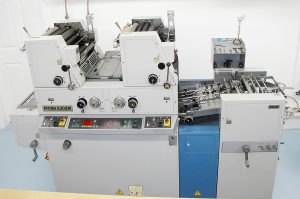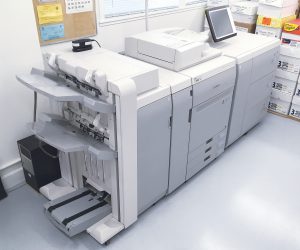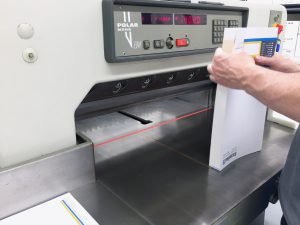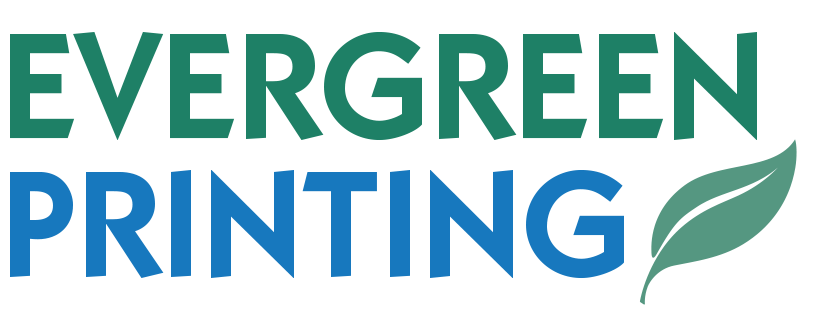Evergreen Printing is a full-service, environmentally responsible, union print shop. As a sole proprietor, I provide high quality offset printing, digital printing, bindery, and design services, all with an unsurpassed attention to detail. Most of my business relationships are long-term, based on years of providing quality work, with the lowest environmental impact, always on time, and at a reasonable price.
(1) Offset Printing: This is the most commonly used process for commercial printing on paper and has been since the 1950s. Although there have been many advancements in technology and automation (as well as a revolution in prepress from analog to digital that has significantly increased the quality of offset printing’s output), the printing process is still basically the same. Offset printing is done either on precut sheets of paper (sheetfed press) or on rolls of paper
(web press). For a brief explanation of how offset printing works, click here.
My offset presses are small 2-color sheetfed presses with a maximum sheet size of about
12″ x 18″. Although I can offset print in full color (cyan, magenta, yellow, and black – or CMYK),  most of my printing is 1, 2, 3, or 4 color with Pantone Matching System (PMS) colors. PMS colors are mixed from 14 mixing colors (rather than just cyan, magenta, yellow, and black), and can therefore produce a much wider range of color. You can pick from any of the more than 1800 PMS colors and I’ll mix your ink to match.
most of my printing is 1, 2, 3, or 4 color with Pantone Matching System (PMS) colors. PMS colors are mixed from 14 mixing colors (rather than just cyan, magenta, yellow, and black), and can therefore produce a much wider range of color. You can pick from any of the more than 1800 PMS colors and I’ll mix your ink to match.
Offset printing offers the highest quality, the greatest number of paper options, the widest color gamut, and the lowest price for larger quantities. Offset printing products include:
Letterhead/stationery
Business cards
Envelopes (many sizes)
Brochures
Flyers
Posters
Newsletters
Booklets
Annual reports
Direct mail
Fundraising appeals
Postcards
Note cards
Notepads
Carbonless forms
Invitations
Hang tags
Gift certificates
Tickets
Membership cards
CD & 7″ record covers
Zines
Stickers
And More!
(2) Digital Printing: This includes a relatively new range of technologies, usually toner or inkjet, that is taking an ever-growing share from traditional printing methods such as offset. This is because digital printing can produce smaller quantities, especially full color, significantly quicker and cheaper compared to offset. With the right design, machine, and operator, the output is excellent.
Digital printing has many advantages, but also has some limitations in relation to offset printing.
It is more expensive for larger quantities, in some cases does not produce as good of an image, produces a narrower gamut of color, has more limited paper options, is less durable when an image goes off the edge of the paper (“bleeds”), and cannot register as well as an offset press. Despite these limitations, digital printing is an excellent complement to offset printing, is often the best-suited process for a project, and is a growing part of my business.
Unlike shops that offer offset or digital, I provide both offset and digital printing and am experienced with the pros and cons of both methods. Therefore, based on your priorities, I can discuss and recommend the most suitable and cost effective printing process and design elements for your project. My digital machines are toner-based with a maximum sheet size of about 13″ x 19″. These are full color (cyan, magenta, yellow, and black) printers that can print in just black or in full color. They are manufactured by Canon and Xerox. Although the toner is more reflective than offset ink, especially on uncoated or non-glossy papers, it is closer to offset than other manufacturers of toner-based printers.
Digital printing products include all of those listed above in the offset printing section, but are usually ordered in smaller quantities. My Canon digital printer also has an inline saddle stapler for making booklets. This, combined with my square edge binder, means that I can affordably produce short-run booklets that lay flat and look great.
(3) Bindery: Prior to and especially after printing, there are often bindery or “postpress” steps required to complete a printing project. These include cutting, collating, folding, binding (a var iety of methods), drilling, scoring, perforating, corner rounding, padding, diecutting, foil stamping, and embossing/debossing. Some of these steps can be done “inline” as part of my digital printing process while other steps are done offline on a different machine. Most can be handled by me. However, I have relationships with several local trade binderies to handle the work I cannot do in-house.
iety of methods), drilling, scoring, perforating, corner rounding, padding, diecutting, foil stamping, and embossing/debossing. Some of these steps can be done “inline” as part of my digital printing process while other steps are done offline on a different machine. Most can be handled by me. However, I have relationships with several local trade binderies to handle the work I cannot do in-house.
(4) Design Services: My years of design experience allow me to produce the best possible product because I can design to the strengths of the particular printing method for your project. I can design from scratch, work with you or your staff, or print files supplied by an outside designer. It doesn’t matter to me. My design rates are very affordable and I will let you know the cost before I begin working on your project. I also often supply customers with digital files of printed output to use internally, for advertising/marketing, or for their websites/social media.
staff, or print files supplied by an outside designer. It doesn’t matter to me. My design rates are very affordable and I will let you know the cost before I begin working on your project. I also often supply customers with digital files of printed output to use internally, for advertising/marketing, or for their websites/social media.
